As an Amazon Associate KitchenwareSets.com earns from qualifying purchases.
Kitchen Dining Room Combo 9 Smart Layout Ideas on a Budget
Are you tired of feeling closed-off in a separate kitchen while your family or guests are enjoying themselves in another room? Formal, closed-off dining rooms are becoming a thing of the past as more of us crave connection, light, and a functional flow in our homes. This separation can make entertaining feel disjointed and everyday family meals feel less connected. It often leads to underutilized formal dining rooms and cramped kitchens, especially in smaller homes and apartments where every square foot counts.
The solution is a kitchen dining room combo, which merges your cooking and eating areas into one open, cohesive space. Also known as an eat-in kitchen, this popular layout is the key to maximizing smaller homes and enhancing social interaction. We’ve helped countless homeowners navigate this exact transition, turning cramped, separate rooms into a single, light-filled space that becomes the heart of the home. It allows hosts to engage with guests during meal prep and creates a modern, inviting atmosphere that perfectly suits today’s casual lifestyle.
Dreaming of an Open, Airy Space? How to Flawlessly Combine Your Kitchen and Dining Room
A kitchen dining room combo, often called an eat-in kitchen, integrates cooking and dining functions into a single, open-concept area. This modern layout is perfect for maximizing space in small homes or apartments, doing away with outdated, formal dining rooms. The primary benefit is enhanced social interaction; you can chat with family or guests while preparing meals, creating a more inclusive and connected atmosphere. By removing walls, you create a seamless flow that makes the entire area feel more spacious, inviting, and perfect for entertaining.
The shift towards combining these spaces reflects a change in how we live. We no longer want to be isolated while cooking. We want a central hub where life happens—from homework and morning coffee to celebratory dinners. This post will give you 9 budget-friendly, actionable ideas to create a beautiful and cohesive kitchen dining combo that you’ll love for years to come.
9 Smart Kitchen Dining Room Combo Layouts You Can Create on a Budget
Ready to transform your space? This section is your practical, idea-packed guide to creating the kitchen dining room of your dreams without breaking the bank. These 9 layouts are curated from top interior design principles and real-world budget makeovers, focusing on ideas that deliver the biggest impact for the lowest cost. We’ll provide clear instructions and pro tips for each strategy, ensuring you feel equipped to implement them regardless of your budget or the size of your space.
Here are 9 smart layouts to inspire your project:
1. Utilize a Kitchen Island as a Divider
2. Embrace Open Shelving
3. Maintain Consistent Flooring
4. Define Zones with Strategic Lighting
5. Employ Area Rugs
6. Opt for Multi-functional Furniture
7. Create an Accent Wall
8. Use Small Round Tables
9. Maximize Vertical Storage
1. Utilize a Kitchen Island as a Multi-functional Divider
A kitchen island is one of the most effective ways to create a functional and visual separation between cooking and dining zones while adding valuable storage and seating. It acts as a natural boundary without closing off the space.
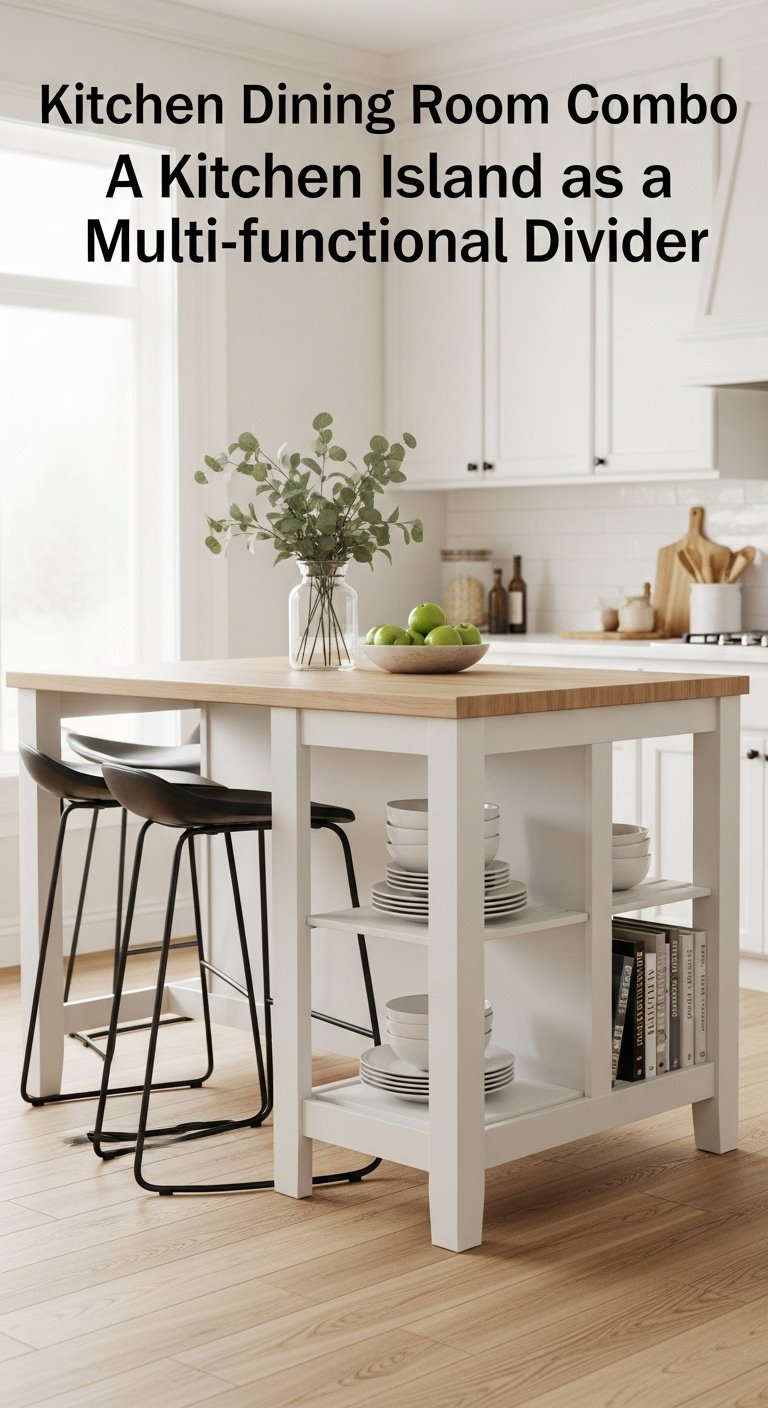
- Materials Needed: Pre-made kitchen island or repurposed console table, bar stools, optional pendant lights, measuring tape.
- Step-by-Step Directions:
- Measure Your Space: Ensure at least 36-42 inches of clearance on all sides of the island for comfortable traffic flow.
- Select Your Island: Choose an island with an overhang on one side to accommodate seating. Prioritize models with built-in storage like shelves or drawers.
- Position Strategically: Place the island to create a natural visual boundary between the cooking and eating areas.
- Add Seating: Tuck bar stools or counter-height chairs under the overhang to create a casual dining spot.
Pro-Tip: For ultimate flexibility in a small space, choose an island on locking casters. It can be moved aside to create more floor space for gatherings or repositioned as needed.
Pin this clever island idea to your ‘Dream Kitchen’ board!
2. Embrace Open Shelving for Cohesion and Storage
Open shelving is a brilliant budget-friendly strategy for visually connecting the kitchen and dining areas. By running shelves along a shared wall, you create a continuous line that tricks the eye into seeing one large, unified space.
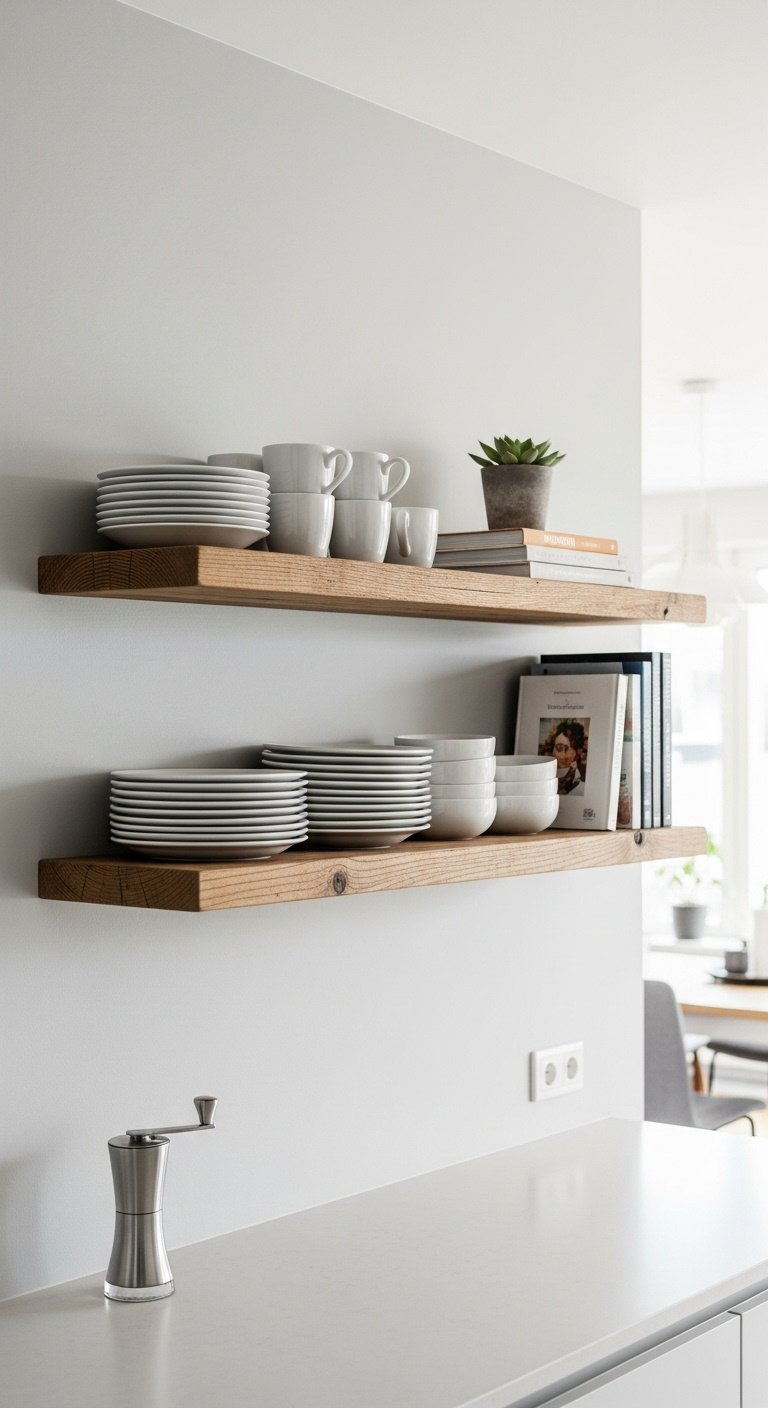
- Materials Needed: Floating shelves, level, drill, wall anchors, stud finder.
- Step-by-Step Directions:
- Plan the Layout: Use painter’s tape to mark where you want the shelves to go. Extend the shelving from the kitchen area into the dining area to create a continuous line.
- Locate Studs: Use a stud finder for the most secure installation. If no studs are available, use heavy-duty wall anchors.
- Install the Shelves: Following the manufacturer’s instructions, drill and mount the shelves, ensuring they are perfectly level.
- Style with Purpose: Arrange a mix of everyday dishes, glassware, and decorative objects. Group items in threes and vary heights for visual interest.
Pro-Tip: To maintain a cohesive look, stick to a limited color palette for the items you display on the shelves. For example, use all white dishes with clear glassware and pops of green from small plants.
Love this look? Save it to your ‘Home Storage Solutions’ board!
3. Maintain Consistent Flooring for a Seamless Flow
Using one type of flooring throughout the entire kitchen and dining space is crucial for creating a seamless, expansive look. It eliminates visual breaks, making the combined area feel larger and more intentionally designed.
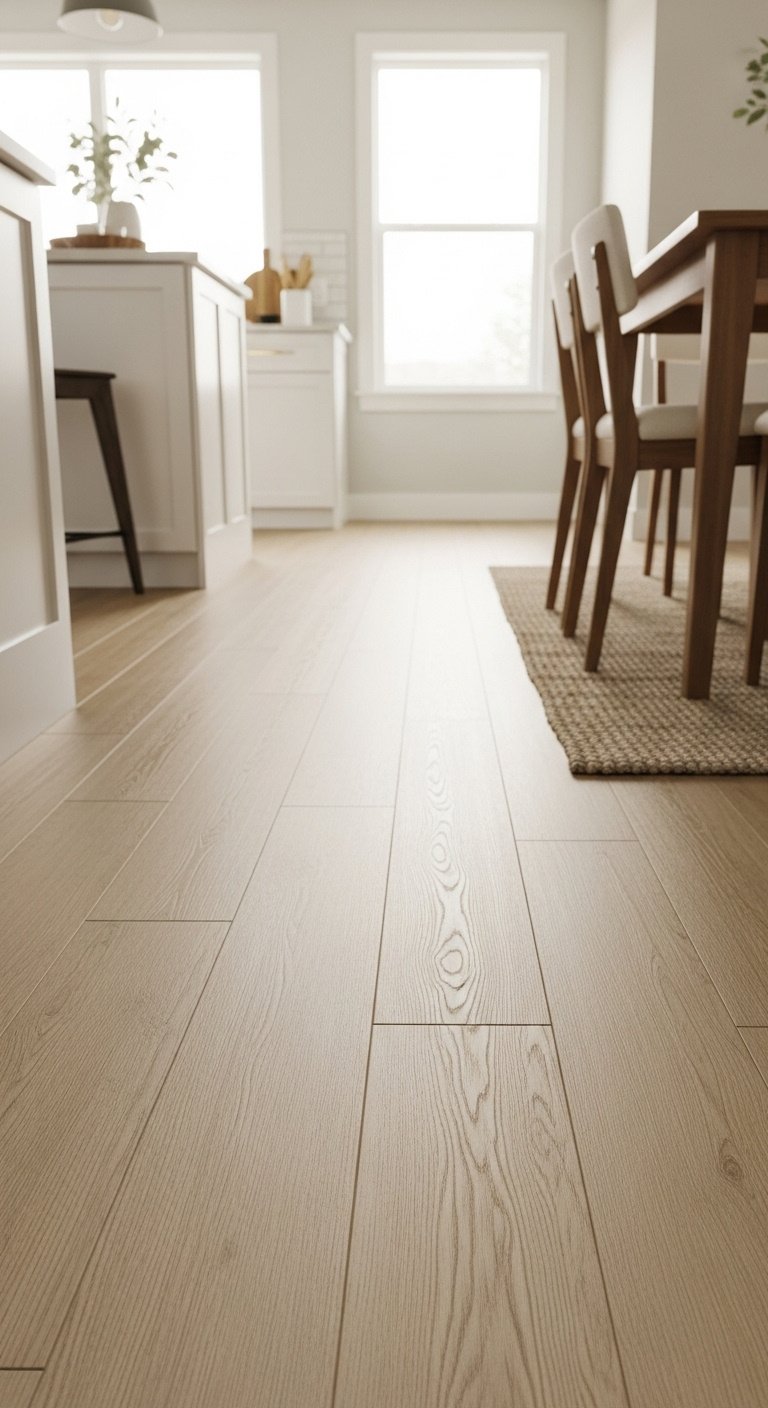
- Materials Needed: Your chosen flooring material (e.g., luxury vinyl plank), underlayment, installation kit (tapping block, pull bar).
- Step-by-Step Directions:
- Choose a Durable Material: Select a flooring option suitable for both kitchen and dining areas. Luxury vinyl plank (LVP) and laminate are excellent budget-friendly, water-resistant choices.
- Prepare the Subfloor: Ensure the subfloor is clean, level, and dry across the entire combined area.
- Install Continuously: Lay the flooring planks in the same direction throughout the kitchen and dining room without using any transition strips between the two “zones.”
- Complete the Look: Install matching baseboards or quarter-round molding along the walls of the entire space for a finished, cohesive look.
Lesson Learned: Avoid breaking up the space with different flooring. A single, uninterrupted floor is one of the most powerful (and subtle) tricks to make an open-concept area feel expansive and intentionally designed.
Share this essential design tip with someone planning a reno!
4. Define Zones with Strategic Lighting
Strategic lighting allows you to create distinct “zones” and set different moods within the open-plan room. A statement fixture over the dining table anchors that space, while functional lighting keeps the kitchen bright and practical.
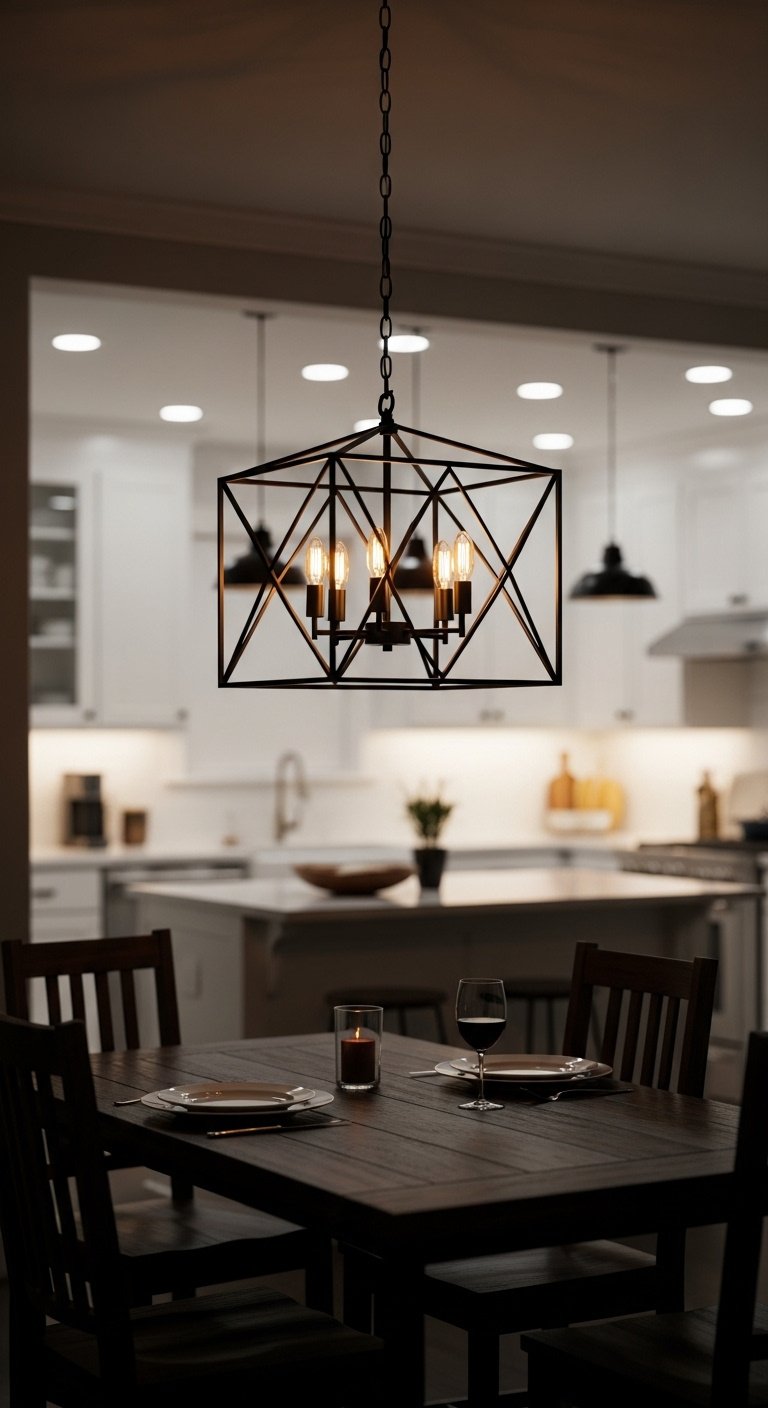
- Materials Needed: Statement pendant light or chandelier, recessed lights or under-cabinet LED strips, dimmer switches.
- Step-by-Step Directions:
- Anchor the Dining Zone: Install a large, eye-catching pendant light or chandelier directly over the center of your dining table. This creates a powerful focal point.
- Illuminate the Kitchen Zone: Use functional lighting in the kitchen. Recessed lights provide great overall illumination, while under-cabinet lighting is essential for task-heavy prep areas.
- Install Dimmer Switches: Add dimmer switches to both lighting zones. This allows you to brighten the kitchen for cooking and dim the lights over the dining area for an intimate dinner atmosphere.
Pro-Tip: When hanging a light over your dining table, the bottom of the fixture should be about 30-36 inches above the tabletop. This provides clear light without obstructing views across the table.
Get inspired! Pin this lighting idea to your ‘Home Decor’ board.
5. Employ Area Rugs to Visually Separate Spaces
An area rug is an incredibly simple and effective tool for defining the dining area within an open-concept room. It visually anchors the table and chairs, creating the feeling of a distinct “room” without any walls.
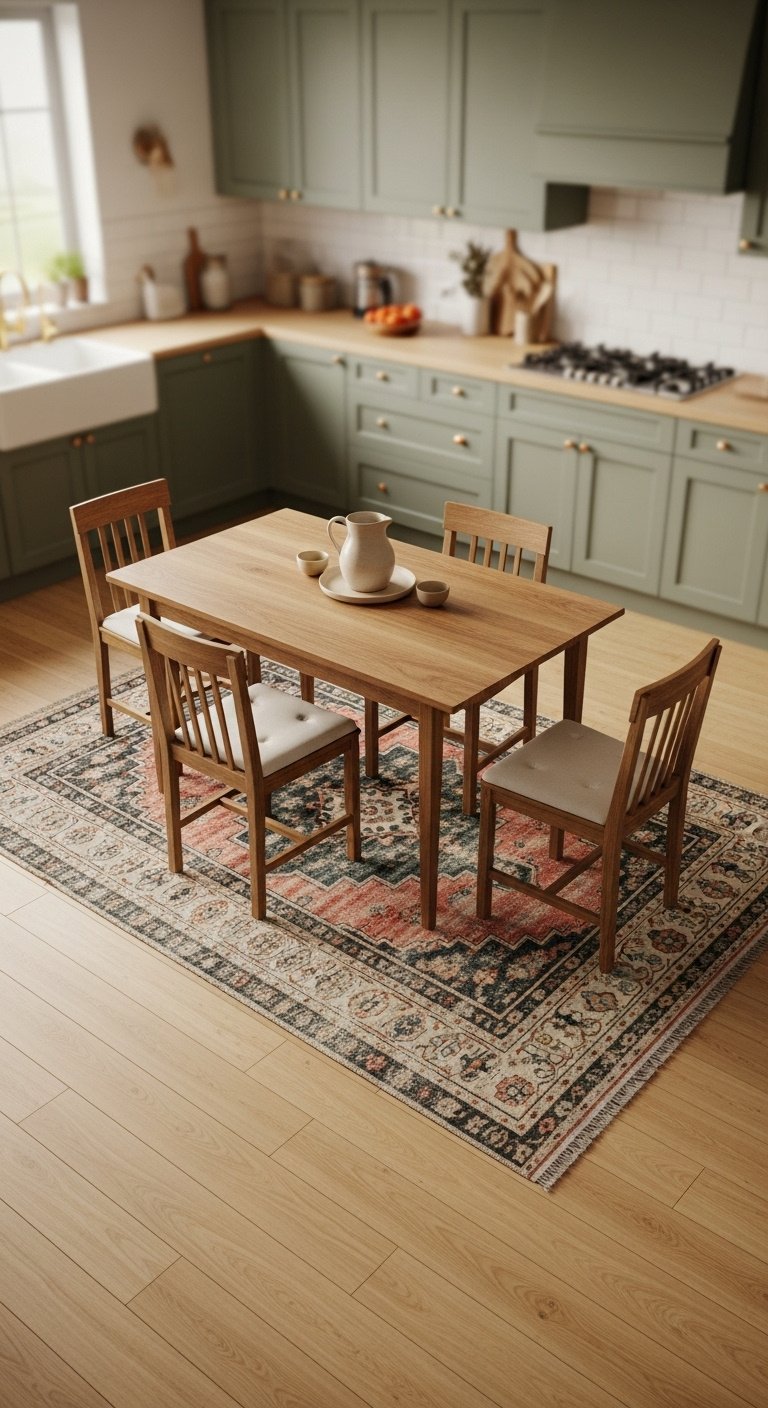
- Materials Needed: An area rug appropriately sized for your dining set.
- Step-by-Step Directions:
- Measure for Size: The rug should be large enough so that when you pull the dining chairs out to sit down, all four legs of the chair remain on the rug. A good rule of thumb is to add 24 inches to each side of your table’s dimensions.
- Choose a Durable Material: Select a low-pile, easy-to-clean rug. Indoor/outdoor rugs are a fantastic, budget-friendly, and durable option for a dining area.
- Center and Place: Position the rug in the designated dining area and center your table and chairs on top of it. This visually grounds the entire set.
Pro-Tip: A rug with a pattern or a dark color is more forgiving of spills and crumbs, making it a practical choice for an eating area, especially if you have children.
Found the perfect rug idea? Save it for later!
6. Opt for Multi-functional and Space-Saving Furniture
In a combined space, choosing furniture that serves multiple purposes is key to maximizing functionality and minimizing clutter. Think smarter, not bigger, with pieces that adapt to your needs.

- Materials Needed: Your chosen multi-functional furniture piece (e.g., an extendable table).
- Step-by-Step Directions:
- Assess Your Needs: Think about your daily use versus when you entertain. An extendable dining table is perfect for small daily meals but can expand to host guests.
- Consider Banquette Seating: A built-in bench or banquette against a wall can save significant floor space compared to chairs that need to be pulled out. Bonus points for building storage into the bench.
- Choose Smart Seating: Opt for dining benches, which can seat more people than individual chairs, or choose stackable chairs that can be stored away when not in use.
Lesson Learned: In a combo space, every piece of furniture should earn its keep. Before buying, ask yourself, “Can this do more than one thing?” A storage bench is always a win.
Steal this space-saving idea for your own home!
7. Create an Accent Wall in the Dining Area
An accent wall is a high-impact, low-cost way to define your dining nook and add a major dose of personality. By painting or wallpapering the wall behind your table, you create a powerful focal point that visually separates it from the kitchen.
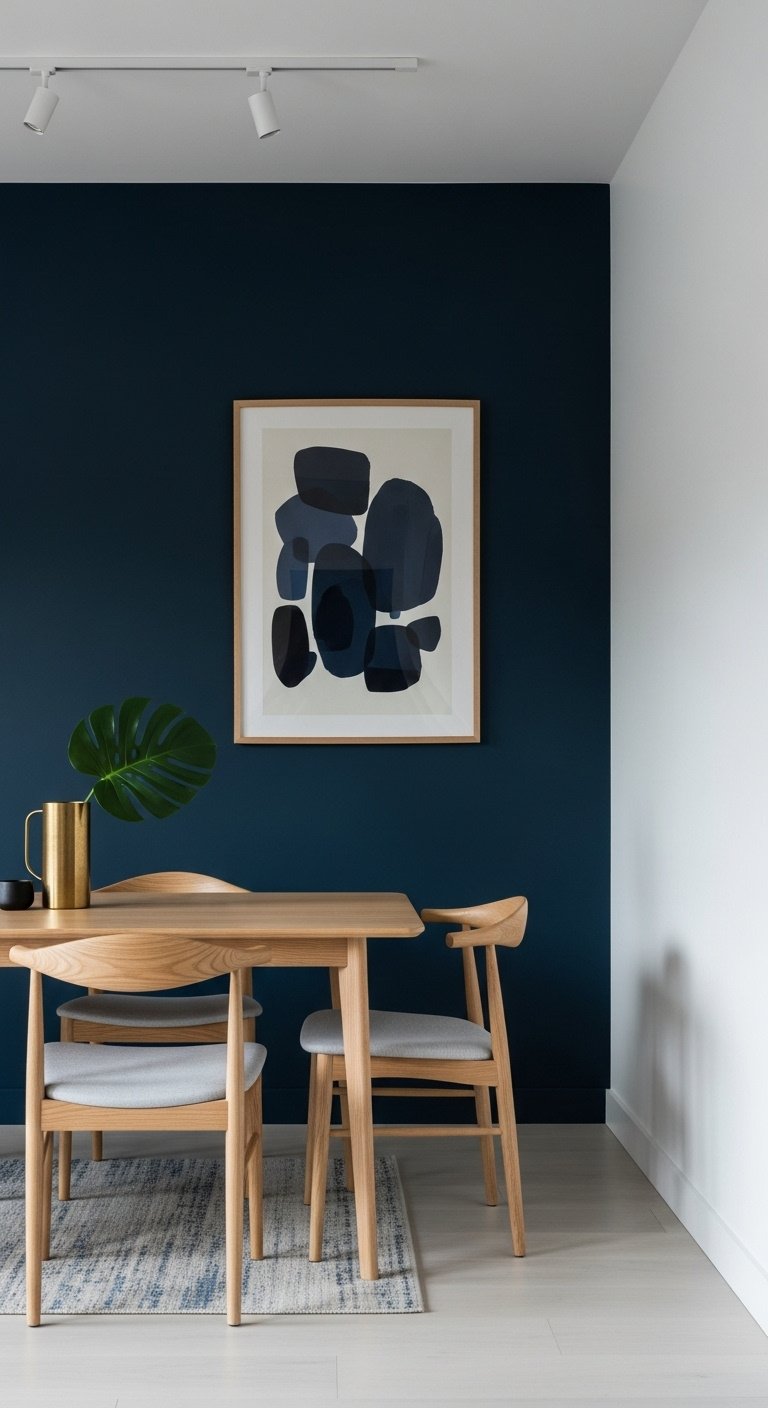
- Materials Needed: Painter’s tape, drop cloth, paint roller and tray, one gallon of your chosen accent color paint.
- Step-by-Step Directions:
- Choose Your Wall: Select the wall behind your dining table. This is the most logical place for a dining room accent wall.
- Select a Bold Color: Pick a color that contrasts with the other walls but complements the kitchen cabinetry or backsplash for a cohesive feel. A deep navy, emerald green, or warm terracotta can work beautifully.
- Prep the Area: Move furniture away from the wall. Use painter’s tape to create clean lines along the ceiling, baseboards, and adjacent walls.
- Paint the Wall: Apply two coats of your chosen color for a rich, even finish. Remove the painter’s tape while the second coat is still slightly damp for the crispest lines.
Pro-Tip: If you’re nervous about a bold color, try a peel-and-stick wallpaper. It’s a low-commitment, budget-friendly way to create a high-impact accent wall and can be easily changed later.
Feeling bold? Pin this accent wall inspiration!
8. Utilize Small Round Tables or Bistro Sets
For very small or narrow spaces, a small round table is the most efficient choice for a dining area. Without corners, it takes up less physical and visual space, improving traffic flow and making the room feel less crowded.
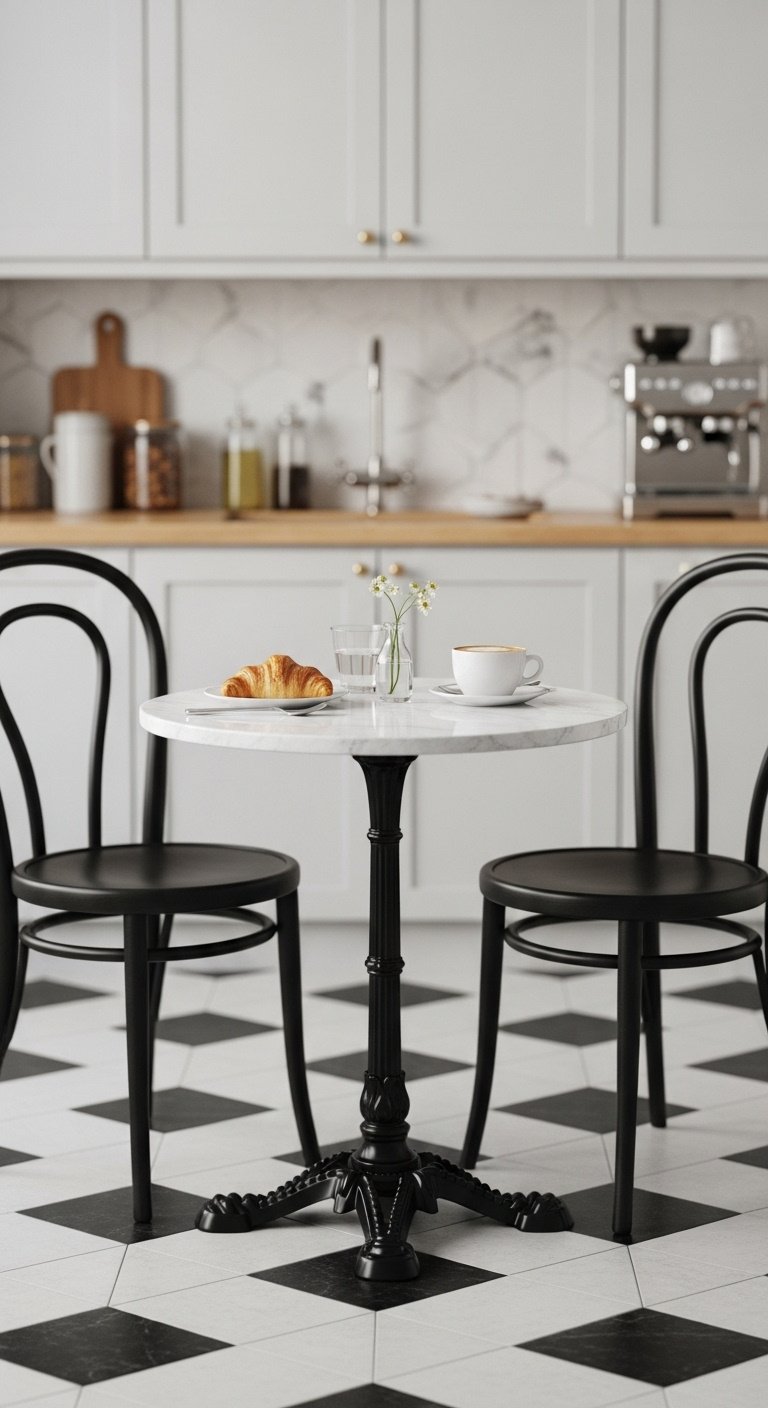
- Materials Needed: A round table or bistro set.
- Step-by-Step Directions:
- Measure the Nook: Identify the corner or small wall space where you want your dining area to be and measure its dimensions.
- Choose Round over Square: A round table has a smaller footprint than a square table of the same seating capacity. The lack of sharp corners also improves the flow of traffic in a tight space.
- Consider a Pedestal Base: A table with a central pedestal base, rather than four legs, allows you to tuck chairs in more easily and offers more legroom.
- Add Charm with a Bistro Set: For the smallest spaces or a household of one or two, a classic two-chair bistro set provides a charming, café-like feel without taking up much room.
Pro-Tip: Pair a small round table with clear acrylic “ghost” chairs. They take up zero visual space, making the dining area feel much larger and less cluttered than it is.
Perfect for small spaces! Save this bistro set idea.
9. Maximize Vertical Storage to Reduce Clutter
To maintain an open and airy feel, use vertical storage to draw the eye upward and keep floors and surfaces clear. Tall, narrow shelving units offer maximum storage with a minimal footprint.
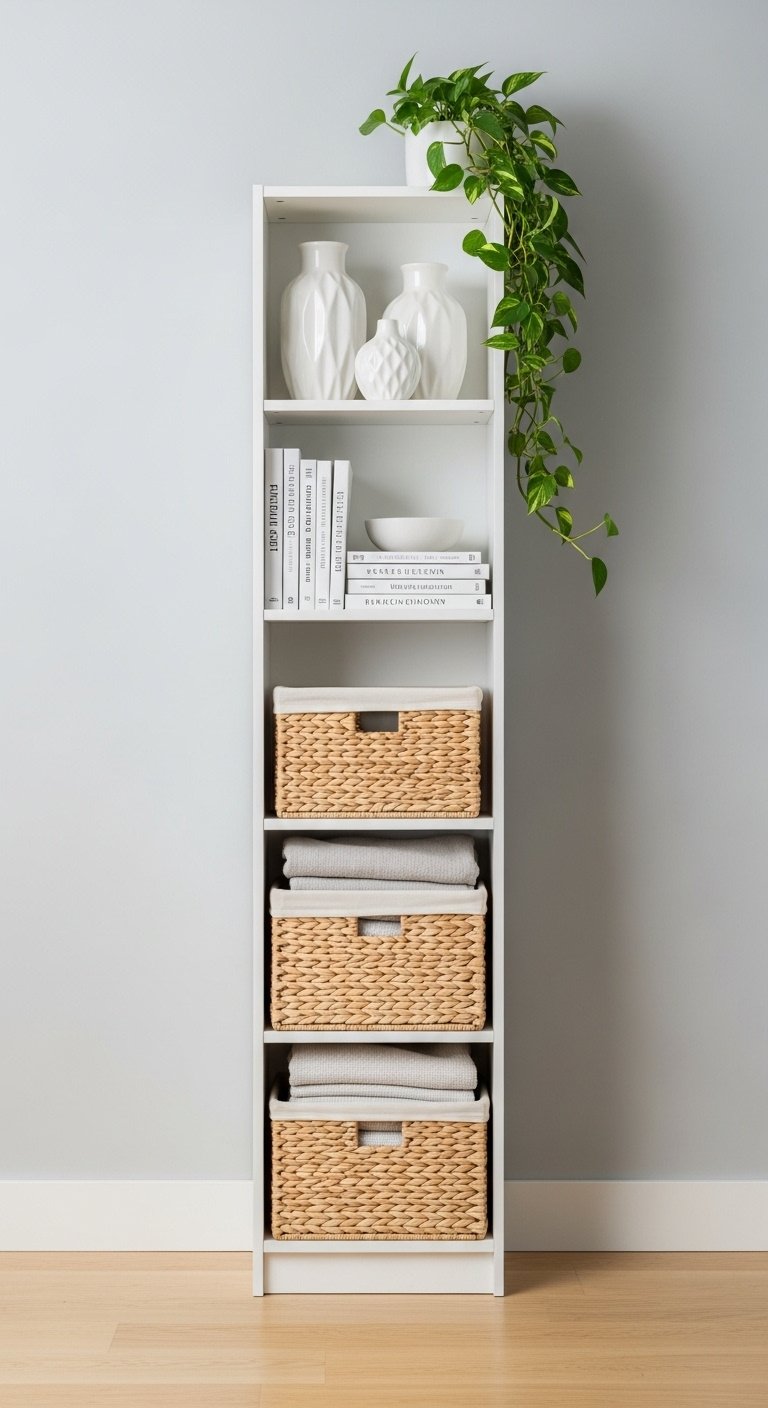
- Materials Needed: A tall, narrow bookshelf or shelving unit (like an IKEA KALLAX or BILLY), wall anchors.
- Step-by-Step Directions:
- Identify a Wall: Find an available wall in the dining area or on the periphery of the kitchen.
- Go Tall and Narrow: Choose a shelving unit that is tall but has a slim profile to minimize its footprint on the floor.
- Anchor to the Wall: Crucially, secure any tall furniture to the wall using anti-tip hardware to prevent accidents.
- Organize with Bins: Use attractive baskets or bins on the shelves to corral smaller items. Use the top shelves for less frequently used items or decor, and the bottom shelves for everyday essentials like napkins or placemats.
Lesson Learned: In an open-concept space, visual clutter is your biggest enemy. By drawing storage upwards, you free up floor and counter space, which is essential for making the room feel open, calm, and organized.
Click to save this brilliant decluttering solution!
Key Takeaways: Your Quick Guide to a Flawless Kitchen Dining Room Combo
- Create Unity: Use consistent flooring and a cohesive color palette throughout the entire space to make it feel larger and more intentional.
- Define Zones without Walls: Employ strategic tools like area rugs under the dining table, statement lighting over the eating area, and a kitchen island to create distinct functional zones.
- Choose Smart Furniture: Opt for multi-functional pieces like extendable tables, storage benches, and round tables to maximize space and functionality.
- Go Vertical: Reduce clutter and maintain an open feel by using tall, narrow shelving and floor-to-ceiling storage solutions.
People Also Ask About Kitchen Dining Room Combos
What do you call a combined kitchen and dining room?
A combined kitchen and dining room is most commonly called an “eat-in kitchen.” Other terms include “kitchen-dining combo” or a “kitchen living room.” It refers to a single, open room that accommodates both cooking facilities and a dedicated dining area, eliminating the need for a separate formal dining room.
How do you combine a kitchen and dining room seamlessly?
To combine a kitchen and dining room seamlessly, focus on creating visual cohesion. Use the same flooring material and a consistent color scheme throughout. Define the dining area with a statement pendant light and an area rug. Finally, use furniture like a kitchen island to create a soft, functional transition between the two zones.
What is the dining room trend for 2025?
The top dining room trends for 2025 emphasize warmth, authenticity, and comfort. This includes the use of warm woods, neutral color palettes, luxurious details like marble or brass, and statement lighting. Curved silhouettes in furniture, such as rounded tables and chairs, are also very popular for creating a soft, inviting atmosphere.
How can I make a small kitchen dining room combo look bigger?
To make a small combo look bigger, use light paint colors and maximize natural light. Opt for space-saving furniture like a round pedestal table and visually lightweight chairs (like acrylic “ghost” chairs). Maintaining consistent flooring and using vertical storage to keep the floor clear are also crucial for creating an illusion of spaciousness.
Final Thoughts
Creating a beautiful, functional kitchen dining room combo that serves as the heart of your home is entirely achievable, no matter your budget. By focusing on unity, defining zones cleverly, and choosing smart, hardworking furniture, you can design a space that feels open, inviting, and perfectly suited to your lifestyle.
Which of these ideas are you most excited to try in your own home? Let us know in the comments below
